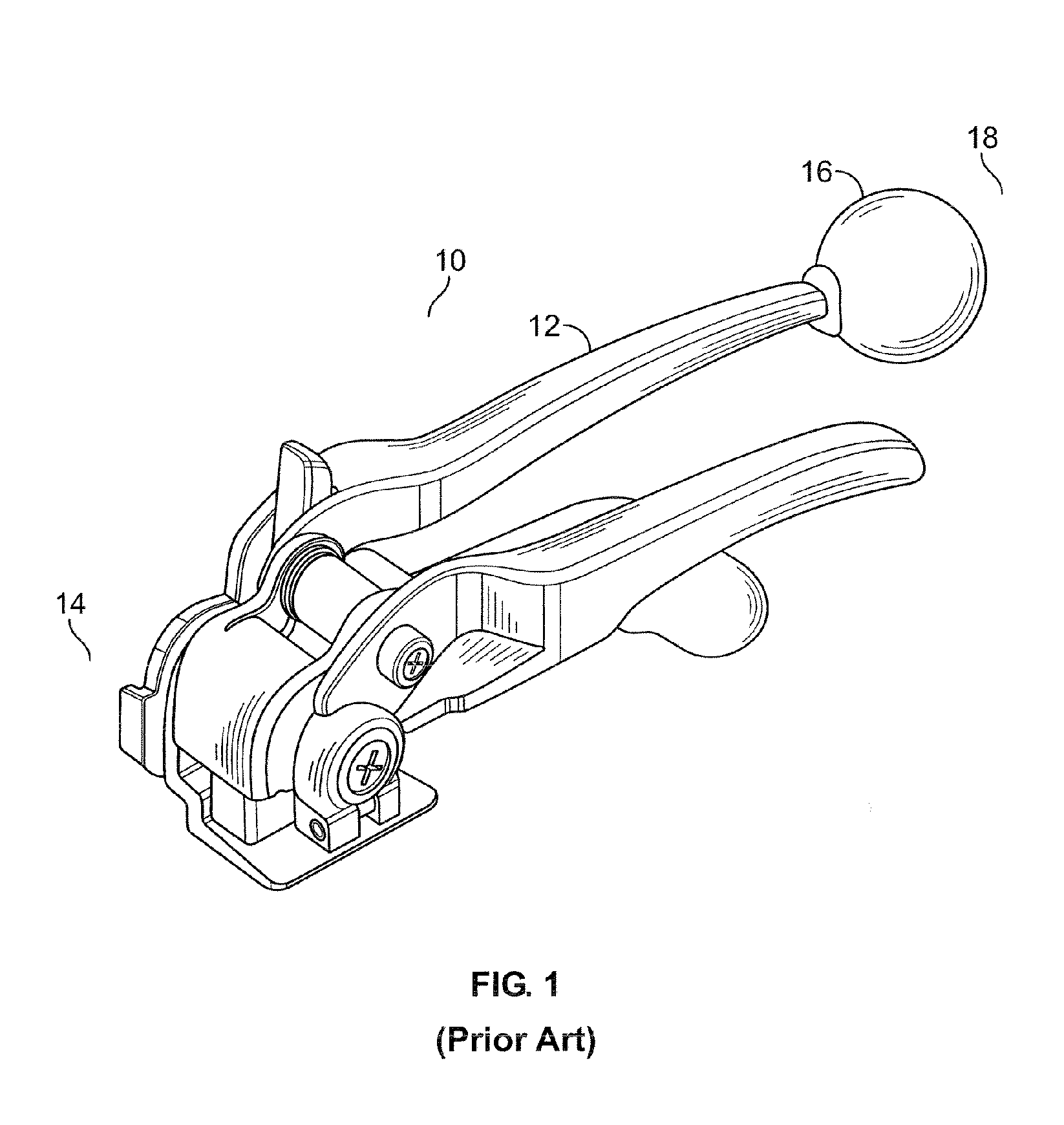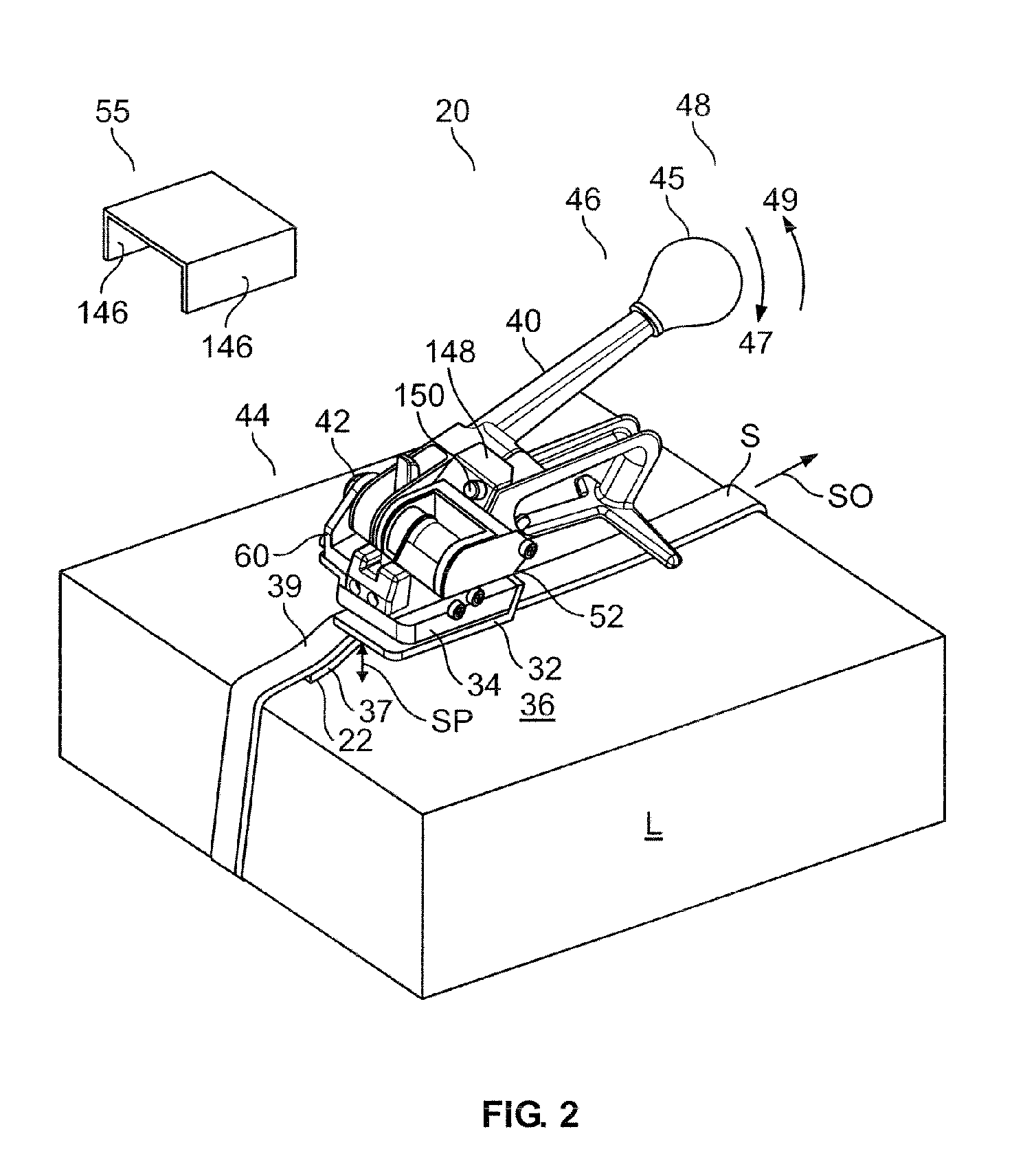Manual tensioner for non-metallic straps
a non-metallic strap and tensioner technology, applied in the field of manual tensioners, can solve the problems of not being able unable to incorporate very cumbersome slack reduction mechanisms, user cannot pull an end of the strap to manually remove excess slack, etc., to achieve the effect of reducing strap slippage and milling, facilitating slack removal, and great downward normal for
- Summary
- Abstract
- Description
- Claims
- Application Information
AI Technical Summary
Benefits of technology
Problems solved by technology
Method used
Image
Examples
first embodiment
[0036]FIG. 3 shows a disassembled view of a tensioner incorporating several aspects of the invention. In the invention, a drive gear 62 is rotatively mounted to the lever 40 so that, when the lever is pressed down (in the direction of arrow 47), the drive gear rotates in a clockwise direction in the direction of arrow 64 (FIG. 4). In a specific embodiment, the drive gear locking mechanism 66 shown in FIG. 4 is used. The drive gear locking mechanism 66 includes a drive pawl 68, pawl pin 70, drive pawl spring 72 and a roll pin 74. The drive gear locking mechanism 66 prevents the drive gear 62 from turning counter-clockwise when, for example, the lever is pulled up, in the direction of arrow 49. Those of skill in the art will appreciate that other types of drive gear locking mechanisms may also be employed.
[0037]Teeth 76 of the drive gear 62 are interlocked with teeth 78 of a tension gear 80 so that, when the drive gear 62 rotates clockwise, the tension gear 80 turns counter-clockwise ...
second embodiment
[0042]Pursuant to the invention, a selective locking mechanism 104 is employed to permit a user to remove slack from the strap. In particular, a user may manually pull the strap S (toward arrow 50 in FIG. 2) to remove excess slack. This causes the feed wheel 30 and the shaft 84 to turn counter-clockwise (in the direction of arrow 82 in FIG. 4). By employing the selective locking system 104, the tension gear 78 and, thus, the drive gear 76 and lever 30, will not move. This reduces the amount of effort that would be necessary to manually remove slack and permits a user to remove a majority of the slack by simply pulling the strap S. Additional desired tension may be achieved by pushing the lever down a minimal number of times.
[0043]In the specific embodiment shown in FIG. 5, the selective locking mechanism 104 includes a pawl-ring assembly 86 and shaped grooves 88 formed on the shaft 84. The pawl-ring assembly 86 includes a ring 106 that pushes the pawl 108 onto the shaft 84. In one e...
third embodiment
[0048]Pursuant to the invention shown in FIG. 3, a gear box 52 assembly includes left, middle and right gear box housing members 136,138, 140. The left and middle members 136, 138 are coupled to one another and to a base plate 142 by removable fasteners 144. The base plate 142 extends upwardly from the base 34. The right member 140 is coupled to the middle housing member 138 by removable fasteners 144. The tension gear 80 is housed between the left and middle members 136, 140, and the feed wheel 30 is housed between the right and middle members 140. Easier access to the tension gear and feed wheel is accomplished by allowing a user to disassemble the gear box 52 by removing the removable fasteners 144.
PUM
| Property | Measurement | Unit |
|---|---|---|
| non-metallic | aaaaa | aaaaa |
| obtuse angle | aaaaa | aaaaa |
| tension | aaaaa | aaaaa |
Abstract
Description
Claims
Application Information
 Login to View More
Login to View More - R&D
- Intellectual Property
- Life Sciences
- Materials
- Tech Scout
- Unparalleled Data Quality
- Higher Quality Content
- 60% Fewer Hallucinations
Browse by: Latest US Patents, China's latest patents, Technical Efficacy Thesaurus, Application Domain, Technology Topic, Popular Technical Reports.
© 2025 PatSnap. All rights reserved.Legal|Privacy policy|Modern Slavery Act Transparency Statement|Sitemap|About US| Contact US: help@patsnap.com



